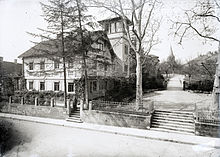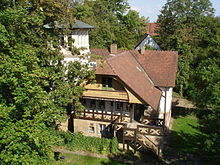Kernerhaus
The Kernerhaus in Weinsberg was the home of the Swabian poet and doctor Justinus Kerner (1786–1862). Due to its numerous authentic testimonies and documents, it is one of the most important memorials of the Swabian Romanticism and, along with the Marbach Schiller National Museum, is one of the most important literary museums in Baden-Württemberg. In addition to the actual Kernerhaus , the Kerner Memorial also includes the neighboring ghost tower and the nearby Alexanderhäuschen .
History of the house
In 1822, the senior medical officer at the time, Kerner, approached the city of Weinsberg and asked for a free building plot on which he wanted to build a house in order to improve his previous unpleasant living conditions. The city agreed to the request and gave Kerner a plot of land with an area of around a quarter of an acre in the Grasigen Hag , a green area outside the city wall, at the foot of the Weinsberg castle hill, created by backfilling the city ditches. There Kerner had a house built for him by his friend, the foreman and architect Johann Georg Hildt .
The one-story house rested on a vaulted cellar. On the first floor there was a guest room, a coach house and a stable. At the entrance to the barn also was probably privy located. Upstairs was Kerner's actual apartment, which comprised the living room, bedroom, study, kitchen and anteroom. In the attic there were two chambers, one of which served as an apartment for the maid.
In 1827 the building was converted into a Swiss house based on a design by the painter Wagner from Heilbronn . H. a wooden extension on wooden posts with a surrounding arbor , extended. The arbor room was used as a dining room, on the floor above was the so-called coffin room , which was named after the vaulted wooden ceiling and was used as a guest room. Further modifications during Kerner's lifetime included a. the chimney situation. Initially there were only two heated rooms in the house, but the heating options were gradually expanded by installing two more chimneys.
In 1824 Kerner acquired the city's earlier prison tower ( theft tower ), which was adjacent to his property within the city wall , made it accessible from his garden through a wall breakthrough and set up a laundry room and a tower room there. The tower is entwined with numerous legends and is therefore also known as the ghost tower . In 1828 Kerner acquired a large garden plot of two parcels not far from his house, on which there was an old house of the dead, which he converted into a guest house and which is now known as the Alexander House . In 1830 he acquired a small piece of land adjacent to his house, thereby enlarging the garden belonging to the house. In 1847 Kerner campaigned for the preservation of the city wall that partially bounded the property.
Due to the attraction of his versatile personality and the hospitality of his wife Friederike, known as Rickele , the house became the central meeting point for Swabian romantics and a meeting place for important personalities from all over the world. The theologian David Friedrich Strauss , a friend of Justinus Kerner and a frequent guest of the Kernerhaus, called it “the strangest and most idiosyncratic house in all of Swabia” and said: “The traveler did not think he was in Swabia if he did not visit Kerner's house . "
After Kerner's death, the house was taken over by his son, the doctor and writer Theobald Kerner , who continued his father's practice. When a citizens' committee wanted to erect a monument to Justinus Kerner in 1864, Theobald Kerner was left to choose the location. In 1864/65 he acquired a plot of land adjacent to the Kernerhaus. The Kernerdenkmal designed by Eduard Herdtle stood in this memorial garden until around 1950 , later the Catholic Church was built there and the memorial was moved directly to the Kernerhaus.
Theobald Kerner had the building rebuilt around 1880. The striking tower was built in the course of this renovation and contains the staircase. By doing without the previous stairs in the house, converting the coach house and stables as well as underpinning the Swiss house and adding a pantry, a lot of additional living space was gained, especially on the ground floor. The upper floor gained the blue room and the red room instead of the previous staircase and anteroom.
Theobald Kerner set a literary monument to the Kernerhaus with his memorial book Das Kernerhaus und seine Guests (1894). The book is one of the most important sources on this historically significant place.
The museum
The listed building with garden and ghost tower has been owned by the Justinus Kerner Association since 1907 and is looked after by the latter. On the occasion of Kerner's 200th birthday in 1986, the house and exhibition were redesigned. The selection and presentation of the exhibits allow the visitor to relive the poet, doctor, art collector, monument conservator, the savior of the Weibertreu castle ruins and founder of the Weinsberg women's association. With the help of personal objects, pictures, manuscripts and books, Kerner's life stations are documented: the town of birth Ludwigsburg , the seminar in Maulbronn , studying in Tübingen , the medical work in Dürrmenz , Wildbad , Welzheim , Gaildorf to Weinsberg , where Kerner finally for over forty years lived and worked. The existing therapy equipment, such as a nerve tuner, a Baquet, with which Kerner treated his famous patient Friederike Hauffe , the so-called seer of Prevorst, his medical instruments or a medical tub from the estate of Franz Anton Mesmer give insights into the medical practice of Kerner's time. Kerner's valuable art collection and the family's living quarters give a fairly accurate picture of his home environment and convey a touch of Kerner's atmosphere and a piece of home decor from the first half of the 19th century. The most beautiful rooms include Kerner's study with the self-made desk, the living and dining room and the so-called coffin room in the attic. The ghost tower in the garden of the Kernerhaus temporarily served as accommodation for the poet Nikolaus Lenau .

Guests in the Kernerhaus
- David Friedrich Strauss , theologian, philosopher and writer
- Count Alexander von Württemberg , officer and poet
- Gustav Schwab , pastor and writer
- Karl Mayer , lawyer and poet
- Karl August Varnhagen von Ense , diplomat and writer
- Ludwig Uhland , poet, playwright and literary scholar
- Nikolaus Lenau , poet and writer
Further literature sites in Weinsberg
With the merger of the Justinus-Kerner-Verein and Frauenverein in 1920, the castle ruin Weibertreu with its stone album , the Kerner monument and, more recently, Kerner's guest house, the Alexanderhäuschen , were added. The result was a museum ensemble that represents a piece of Swabian romantic literature and intellectual history. The grave of Justinus Kerner and his family is also located in the Weinsberg cemetery. The Rappenhof near Weinsberg was the temporary residence of the writer Juliane von Krüdener . There is a memorial room in the Gutsgasthof.
literature
- The singers at the Weinsberger Thurm . In: The Gazebo . Issue 1, 1866, pp. 4–8 ( full text [ Wikisource ] - with illustration by Heinrich von Rustige ).
- Simon M. Haag: On the building history of the upper administrative town of Weinsberg . Verlag Nachrichtenblatt der Stadt Weinsberg, Weinsberg 1995, ISBN 3-9802689-8-5 , pp. 237-253.
- Theobald Kerner: The Kernerhaus and its guests . Stuttgart 1894.
- Justinus Kerner. Poet and doctor, 1786–1862 . German Schiller Society, Marbach am Neckar 1986 (Marbacher Magazin, 39).
- Eckart Roloff , Karin Henke-Wendt: A mysterious soul researcher and poet. (Kernerhaus, Weinsberg) In: Visit your doctor or pharmacist. A tour through Germany's museums for medicine and pharmacy. Volume 2: Southern Germany . Verlag S. Hirzel, Stuttgart 2015, ISBN 978-3-7776-2511-9 , pp. 79-81.
Web links
- The Kernerhaus at the Justinus-Kerner- und Frauenverein Weinsberg
- The Kernerhaus near Literaturland Baden-Württemberg
Coordinates: 49 ° 9 ′ 8.17 ″ N , 9 ° 17 ′ 19.6 ″ E





